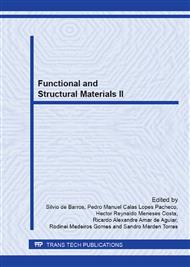p.107
p.113
p.119
p.125
p.133
p.139
p.147
p.157
p.165
Geopolymerics Adhesives for Joint Steel Plates
Abstract:
The process of bonding degradation throughout the whole loading phase up to the total collapse has been investigated by models of interlaminar degradation in composite materials and subsequently adapted to the problem of structural bonding. The physical phenomenon represented by these models is exactly the same that must be studied in the case of metal plates adhered with geopolymers: the adhesion between substrates. In this work, it was investigated the adherence of joint steel plates through propagation tests of clefts in mixed mode MMF (Mixed-Mode Flexure Test) which combine the efforts of traction (due to differential thermal expansion) and shear (due the slipping and preassure due the own weight of the adhered layers), in other words, modes I (pure opening) and II (pure shear) of propagation, being one of the most common glued plates. It was used two types of geopolymeric adhesives (one made of metakaolinite and another with weathered soil) activated with sodium silicate. The bonded systems were subjected to temperatures between 55°C and 600°C in order to evaluate its potential against the use of epoxy-based adhesives. The substrates used were steel. In general, the adhesives made of metakaolinite had better adhesion.
Info:
Periodical:
Pages:
133-137
Citation:
Online since:
June 2013
Keywords:
Price:
Сopyright:
© 2013 Trans Tech Publications Ltd. All Rights Reserved
Share:
Citation:


